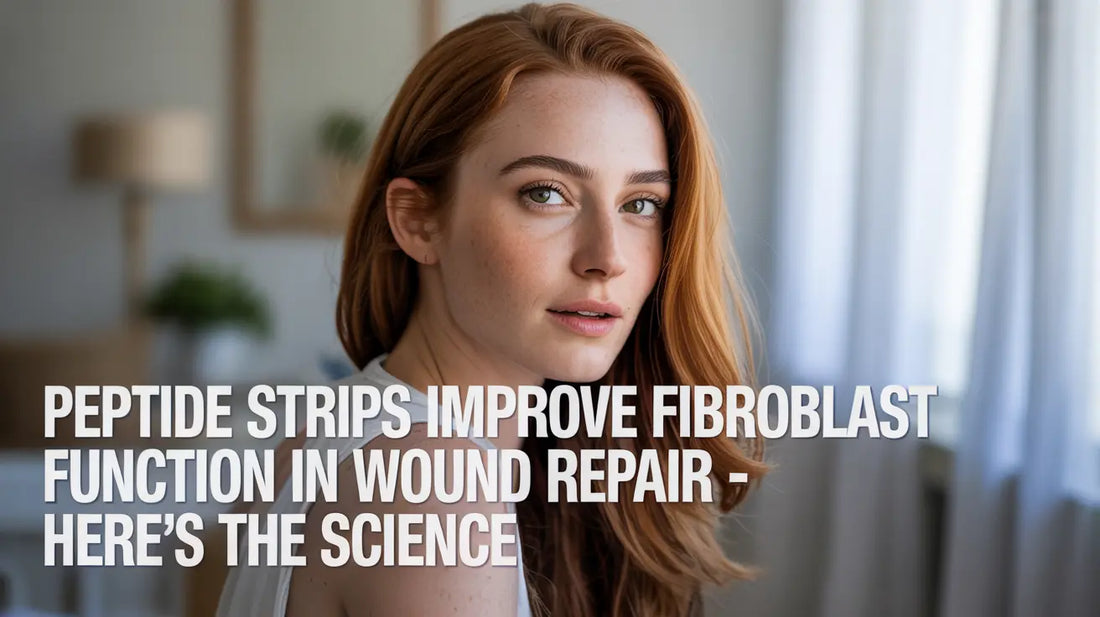
Peptide Strips Improve Fibroblast Function in Wound Repair – Here’s the Science
Share
Peptide strips have been shown to enhance fibroblast activity, which plays a central role in wound repair. Fibroblasts are the skin’s natural repair agents responsible for producing collagen, forming new tissue, and orchestrating key healing processes. When oral peptide strips are used consistently, they can stimulate these cells, resulting in quicker and more effective healing outcomes.
Here’s a science-backed look into how peptide strips influence fibroblast function and accelerate wound healing.
Why Fibroblasts Are Critical to Healing
Fibroblasts are essential cells in the skin's dermis layer. They help rebuild damaged tissue after a wound.
Role of Fibroblasts in Wound Healing
Fibroblasts support repair by:
- Producing collagen and extracellular matrix to close and strengthen wounds.
- Signaling to immune cells and coordinating the wound healing stages.
Phases Where Fibroblasts Are Active
These cells are especially active in the proliferation and remodeling phases, where they:
- Lay down new connective tissue.
- Remodel the scar over time to restore skin flexibility.
How Peptide Strips Enhance Fibroblast Activity
Oral peptide strips contain bioactive compounds that reach the bloodstream via the mucosa, activating repair at the cellular level.
Specific Peptides That Support Fibroblasts
Key peptides found in strips that stimulate fibroblasts include:
- GHK-Cu: A copper peptide known to increase collagen production and fibroblast migration.
- BPC-157: Supports fibroblast proliferation and tissue regeneration even in harsh wound environments.
Mechanisms of Action
These peptides work by:
- Binding to cellular receptors on fibroblasts to upregulate growth factor signaling.
- Enhancing angiogenesis, which brings nutrients to the wound site and supports fibroblast function.
Clinical Evidence of Peptide Impact on Fibroblasts
Studies on peptide-based therapies have consistently shown improved fibroblast behavior and better healing outcomes.
Animal and Lab Studies
- Rodent models with peptide strips demonstrated increased fibroblast activity and quicker wound closure.
- Lab-grown fibroblast cultures exposed to GHK-Cu peptides showed improved collagen production within 24 hours.
Human Use Cases
Early case studies on surgical wounds and skin injuries show faster recovery and reduced scarring when peptide strips were used consistently.
Best Practices for Maximizing Fibroblast Response with Peptides
For peptides to effectively activate fibroblasts, application and dosage must be optimized.
Use Consistently and Early in Healing
- Start peptide therapy as soon as the wound is clean and stabilized.
- Continue daily use during the first two weeks when fibroblast activity is highest.
Combine with Proper Wound Care
- Clean wounds regularly to prevent infection.
- Use moisturizers or occlusive dressings to maintain a healing environment that supports fibroblast work.
Comparing Peptide Strips to Other Fibroblast Therapies
There are other fibroblast-targeting therapies, but peptide strips offer unique advantages.

Topical vs. Oral Delivery
- Topical creams may not penetrate deeply enough to activate dermal fibroblasts.
- Oral strips bypass digestion and reach systemic circulation, activating fibroblasts both locally and systemically.
Growth Factors vs. Peptides
- Growth factors like EGF are powerful but expensive and often unstable.
- Peptides are more stable, cost-effective, and easier to store and apply.
Risks or Limits of Fibroblast Stimulation
While stimulating fibroblasts is beneficial, there are some limits and precautions.
Risk of Excessive Fibrosis
- Overstimulation can lead to dense scarring or fibrosis in rare cases.
- Patients prone to keloids should use under medical supervision.
Quality of Peptide Product Matters
- Low-quality or unregulated peptide strips may not contain effective doses.
- Always choose products with lab validation and clinical backing.
FAQs About Peptide Strips and Fibroblast Function
Here are some questions and answers about how peptide strips help improve fibroblast activity during wound healing:
How do peptide strips influence fibroblast cells?
Peptides like GHK-Cu activate fibroblast receptors, triggering them to produce more collagen and aid in tissue remodeling.
Are there studies showing this effect?
Yes, both in-vitro and animal studies show increased fibroblast proliferation and faster healing with peptide exposure.
Can I use peptide strips on any wound?
They are best used for clean, non-infected wounds. Deep wounds, infected areas, or burns should be evaluated by a doctor first.
Do peptide strips work better than collagen creams?
Yes, because they activate fibroblasts to produce collagen naturally, rather than just applying collagen externally.
How long should I use peptide strips to see fibroblast benefits?
Use daily for at least 7 to 14 days for noticeable improvement in wound strength and healing time.
When used properly, oral peptide strips can activate fibroblasts more effectively than many conventional wound healing products — speeding up tissue regeneration and reducing scarring risks.
